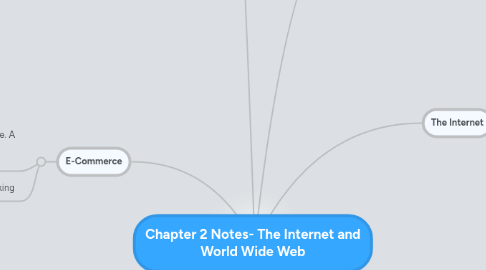
1. How the Internet Works
1.1. Connecting to the Internet
1.1.1. Dial-up access takes place when the modem in your computer uses a standard telephone line to connect to the Internet
1.1.2. DSL- a technology that provides high-speed Internet conncetion using regular copper telephone lines
1.1.3. Cable modem- allows access to high-speed Internet services through the cable television network
1.1.4. Wi-Fi- network that uses radio signals to provide Internet conncetions to wireless computers and devices
1.2. How Data Travels the Internet
1.2.1. Several main transmission media carry the heaviest amount of traffic on the Internet called the Internet Backbone
1.3. Access Providers
1.3.1. Access provider- a business that provides individuals and companies access to the Internet
1.3.1.1. Wireless Internet Service Provider- a company that provides wireless Internet access to desktop and notebook compiters and mobile devies, such as smart phones and PDA's with built-in wireless capability
1.4. Internet Addresses
1.4.1. IP Address- a number that uniquely identifies each computer or device connected to the Internet
1.4.2. Domain Name- test version of an IP Address (ex. www.google.com)
2. The World Wide Web (WWW)
2.1. Browsing the Web
2.1.1. Web consists of a worldwide collection of electronic documents each called a Web Page
2.1.2. A Web site is a collection of related web pages and associated items, such as documents and pictures stored on a Web server
2.1.3. A Web browser is an application software that allows users to access and view Web pages (ex. Safari, Firefox)
2.1.4. Dowloading- the process of a computer receiving information, such as a Web page, from a server on the Internet
2.2. Web Addresses
2.2.1. Link- a built-in connection to another related Web page or part of a Web page
2.2.2. Surfing the Web- refers to the activity of using links to explore the Web
2.2.3. Each link on a Web page corresponds to a Web address or a document
2.3. Searching for Information on the Web
2.3.1. Search engine- a program that finds Web sites, web pages, images, news, videos, and oter information related to a specific topic
2.3.2. Search engines are helpful in locating Web pages about certain topics or in locating specific web pages, images, videos, news, and other information for which you do not know the exact Web address
2.3.3. Subject Directories- provide categorized lists of links arranged by subject
2.4. Types of Web Sites
2.4.1. Portal- a web site that offers a variety of Internet services from a single, convenient location
2.4.2. News- contains newsworthy material including stories and articles relating to current events
2.4.3. Informational- contains factual information
2.4.4. Business/Marketing- contains content that promotes or sells products or services
2.4.5. Educational- offers exciting, challenging avenues for formal and informal teaching and learning
2.4.6. Entertainment- offers an interactive and engaging environment
2.4.7. Advocacy- contains content that desribes a cause or idea
2.4.8. Blog- informational web site consisting of time-stamped articles or posts, in a diary or journal format, usually listed in reverse chronological order
2.4.9. Wiki- a callaborative Web site that allows users to create, add to, modify, or delete the web site content via their Web browser
2.4.10. Social Network- web site that encourages members in its online community to share their interests, ideas, stories, photos, music, and videos with other registered users
2.4.11. Content Aggregator- a business that gathers and organizes Web content and then distributes the content to subscribers
2.4.12. Personal- a private individual or family not usually associated with any organizaton may maintain a personal Web site or just a single web page
2.5. Multimedia on the Web
2.5.1. Multimedia- refers to any application that combines text with graphics, animation, audio, or video
2.5.2. Graphics- a digital representation of nontext information such as a drawing, chart, or photo
2.5.3. Animation- the appearance of motion created by displaing a series of still images in sequence
2.5.4. MP3- audio file reduced to about one-tenth of its orginal size that preserves much of the original quality of the sound
2.5.5. Video- consists of a full-motion images that are played back at various speeds
2.5.6. Virtual Reality- the use of computers to stimulate a real or imagined environment that appears as a 3D space
2.5.7. Plug-ins- a program that extends the capability of a browser
2.6. Web Publishing
2.6.1. The development and maintenance of Web Pages.
3. E-Commerce
3.1. E-commerce- short for electronic commerce. A business transaction that occurs over an electronic network such as the Internet
3.2. Includes shopping, investing, and banking
4. Other Internet Services
4.1. E-Mail- the transmission of messages and files via a computer network
4.2. Mailing Lists- a group of email names and addresses given a single name
5. The Internet
5.1. The Internet (Net) is a worldwide collection of networks that links millions of businesses, government agencies, educational institutions, and individuals
5.2. Widely used research tool, providing society with access to global info and instant communication
6. The History of the Internet
6.1. ARPANET- goals were to build a network that scientists at different locations to share info and work together and could function even if part of the network were disabled or destroyed by a disaster
6.1.1. New node
